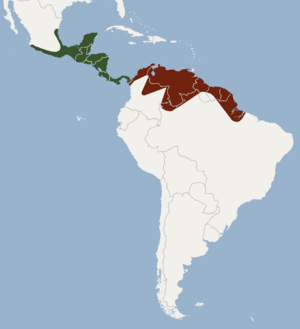Common big-eared bat facts for kids
Quick facts for kids Common big-eared bat |
|
|---|---|
 |
|
| Conservation status | |
| Scientific classification | |
| Genus: |
Micronycteris
|
| Species: |
microtis
|
 |
|
The common big-eared bat (Micronycteris microtis) is a small bat species. You can find it in South and Central America. It is part of a bat family called Phyllostomidae.
These bats are amazing at finding food! Most bats find prey by listening for movements, like flapping wings. But the common big-eared bat can find food that is completely still. It can even find food hidden in messy places, like among leaves. This bat sends out sounds through its nose, just like other bats in its family. But its special skill to find hidden, motionless prey makes it unique.
The common big-eared bat uses special sounds to echolocate. These sounds are high-pitched and sweep through different frequencies. They are similar to the sounds made by another bat called Macrophyllum macrophyllum.
Bat mothers are very caring! Common big-eared bat mothers will bring food to their babies for about five months after the babies stop drinking milk.
What Does It Look Like?
This bat is quite small. It usually weighs between 3.4 and 9.1 grams (about the same as a few paper clips!). Its forearm, which is part of its wing, is about 32 to 38 millimeters long.
Its ears are big and round, measuring 18 to 23 millimeters long. A special membrane connects its ears. The bat's fur is brown, but the exact shade of brown can be different depending on where it lives. It has 34 teeth in total.
Where Does It Live?
The common big-eared bat lives in many countries across Central and South America. You can find it in:
- Belize
- Bolivia
- Brazil
- Colombia
- Costa Rica
- El Salvador
- French Guiana
- Guatemala
- Guyana
- Honduras
- Mexico
- Nicaragua
- Panama
- Venezuela
See also
- In Spanish: Murciélago orejón andino para niños


